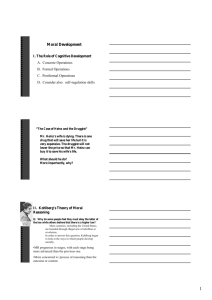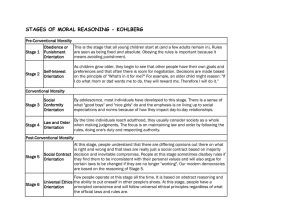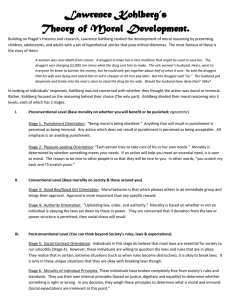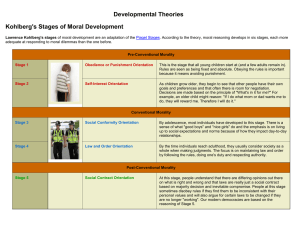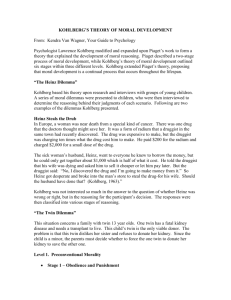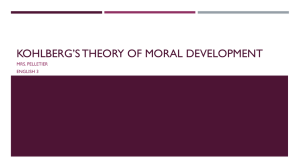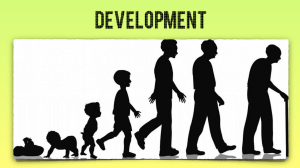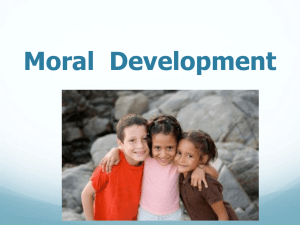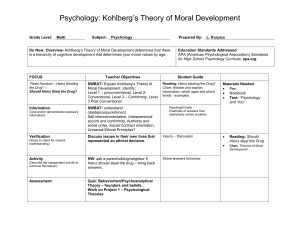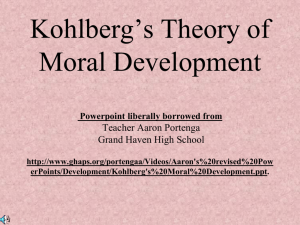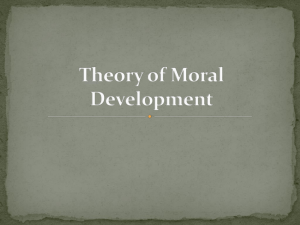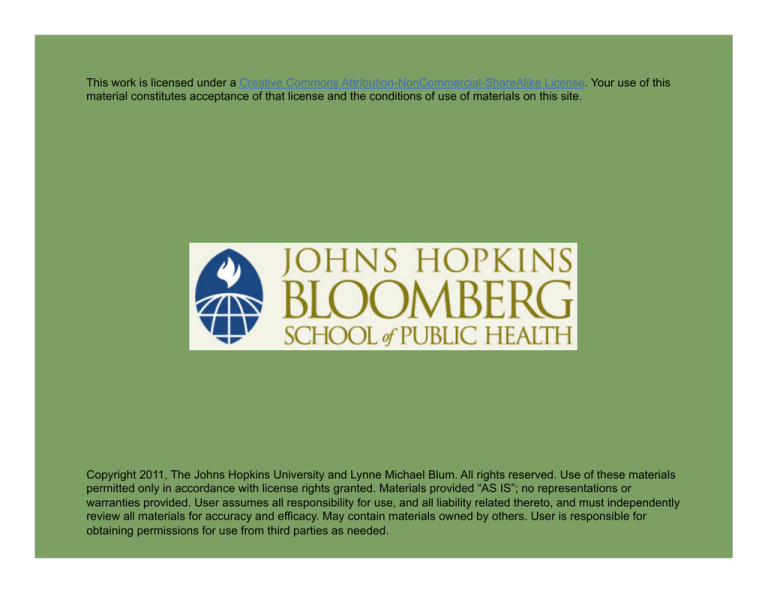
This work is licensed under a Creative Commons Attribution-NonCommercial-ShareAlike License. Your use of this
material constitutes acceptance of that license and the conditions of use of materials on this site.
Copyright 2011, The Johns Hopkins University and Lynne Michael Blum. All rights reserved. Use of these materials
permitted only in accordance with license rights granted. Materials provided “AS IS”; no representations or
warranties provided. User assumes all responsibility for use, and all liability related thereto, and must independently
review all materials for accuracy and efficacy. May contain materials owned by others. User is responsible for
obtaining permissions for use from third parties as needed.
Cognitive, Moral, and Social
Development in Childhood—Part II
Lynne Michael Blum, MS, PhD
Johns Hopkins University
Section A
Moral Development
Piaget’s Two-Stage Theory
Kids below 10 or 11 years:
- Rules are fixed and absolute
- Rules are handed down by adults and no one can change them
- Base judgment on consequences
The older child’s view is more relativistic
- Rules are not sacred and absolute but are devices which humans
use to get along cooperatively
- Base judgment on intentions
Teacup dilemma (Piaget, 1932)
4
Kohlberg’s Stages of Moral Development
Based on interviews with children and teens
First three stages based on Piaget and last three stages go beyond
Piaget
1958 research: 72 males in Chicago, ages 10, 13, and 16 years old
- SES: lower- and middle-class
1963 and 1970: added to sample with girls, delinquents, and kids
from other countries
5
Heinz Dilemma
In Europe, a woman was near death from a special kind of cancer.
There was one drug that the doctors thought might save her. It was
a form of radium that a druggist in the same town had recently
discovered. The drug was expensive to make, but the druggist was
charging ten times what the drug cost him to make. He paid $200
for the radium and charged $2,000 for a small dose of the drug. The
sick woman’s husband, Heinz, went to everyone he knew to borrow
the money, but he could only get together about $1,000 which is
half of what it cost. He told the druggist that his wife was dying and
asked him to sell it cheaper or let him pay later. But the druggist
said: “No, I discovered the drug and I'm going to make money from
it.” So Heinz got desperate and broke into the man’s store to steal
the drug-for his wife. Should the husband have done that?
Source: Kohlberg. (1963).
6
Moral Reasoning Research
Moral reasoning research aimed to understand decision making
Three levels, six stages of moral reasoning
- Pre-conventional
- Conventional
- Post-conventional
7
Pre-Conventional Morality
Young children beginning around age 3 or 4 will make decisions
without thinking
- Decisions are based on rules dictated by adults
As they mature into childhood, they learn perspective-taking that
allows them to realize how to negotiate and persuade others to
bend the rules for mutual benefit
8
Stage 1: Obedience and Punishment
Authorities hand down a fixed set of rules which he or she must
unquestioningly obey
To the Heinz dilemma, the child typically says that Heinz was wrong
to steal the drug because “He’ll go to jail” or “It's bad to steal”
9
Stage 2: Individualism
Used car salesman stage: “What’s in it for me?”
- At this stage children recognize that there is not just one right
view that is handed down by the authorities
- Different individuals have different viewpoints
“Since Heinz needs it, he should take it and the druggist
will understand” or …
“It wouldn’t do any good to take the drug because his wife
will die while he is in jail”
10
Level II, Conventional Morality
Kohlberg found that most teens and adults remain at the level of
conventional morality
These stages focus on living out of respect for the boundaries set by
the peer group and the laws of the community
There is a shift from unquestioning obedience to a relativistic
outlook and to a concern for motives
11
Stage 3: Good Interpersonal Relationships
The teen who conforms to the conventions of his peer group and the
adult who conforms as the “nice” guy
- They believe that people should live up to the expectations of
the family and community and behave in “good” ways
- Good behavior means having good motives and interpersonal
feelings such as love, empathy, trust, and concern for others
12
Stage 4: Law and Order Stage
At stage 4, the respondent becomes more broadly concerned with
society as a whole. Now the emphasis is on obeying laws, respecting
authority, and performing one’s duties so that the social order is
maintained.
In response to the Heinz story, many subjects say they understand
that Heinz’s motives were good, but they cannot condone the theft.
What would happen if we all started breaking the laws whenever we
felt we had a good reason? The result would be chaos; society
couldn't function.
Source: Gibbs et al. (1983).
13
Level III, Post-Conventional Morality
Reasoning is based on principles
The early principled reasoning is still conventional
Later principled reasoning will forsake the rules and
conventions of society in order to follow principles
14
Stage 5: Social Contract and Individual Rights
At stage 5, people begin to ask “What makes for a good society?”
They step back from their own society and consider the rights and
values that a society ought to uphold.
Society should have two basic rights:
- Society should protect them
- Laws should accommodate people’s rights
15
Stage 6: Universal Principles
At stage 6, the principles of justice guide individuals toward
decisions based on an equal respect for all. Stage 6 thinkers are
“post law” and no longer accept their own society as given but think
reflectively and autonomously about what a good society should be.
Gandhi and Martin Luther King exemplify these principals.
If the druggist were a stage 6 thinker, he would not have locked his
door. If Heinz used stage 6 reasoning, he would take the drug, then
turn himself in and take the consequences of his actions.
16
The Overlap of Moral and Social/Emotional Stages
Pre-conventional reasoning: from egocentrism to mutually
beneficial deals
Conventional reasoning values the community’s needs first and
individual’s perspectives within that
Post-conventional reasoning: principles are more important than
either individuals or community
Stage 5 emphasizes democratic processes, and stage 6 considers
how all parties take one another’s perspectives according to the
principles of justice
17
Gilligan’s Stages of Moral Development
Carol Gilligan (1982)
- Kohlberg's stages were derived exclusively from interviews with
males
- The stages reflect a decidedly male orientation
Gilligan’s stages of female moral development
- Egocentric
- Sociocentric
- Reciprocal
18
Criticism: Cultural Bias
Kohlberg believed stage sequence is universal
- Don't different cultures socialize their children differently,
teaching them very different moral beliefs?
Kohlberg's response is that different cultures do teach different
beliefs, but that his stages refer not to specific beliefs but to
underlying modes of reasoning (Kohlberg and Gilligan, 1971)
19

